The Bigger Picture: Considerations Toward the Sustainable Localization of Mine Action
By Mark Wilkinson, PhD [ DanChurchAid ], Albert Schevey [ DanChurchAid ], and Ahmed Al Zubaidi, PhD [ Iraqi Health and Social Care Organisation ]
CISR Journal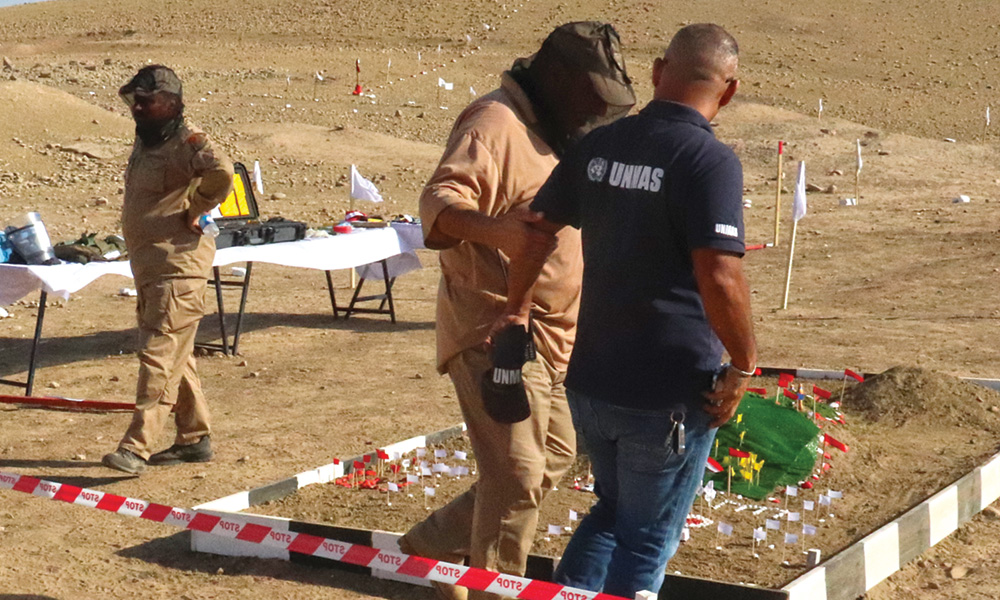
This article is brought to you by the Center for International Stabilization and Recovery (CISR) from issue 27.1 of The Journal of Conventional Weapons Destruction available on the JMU Scholarly Commons and Issuu.com.
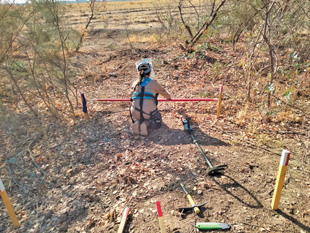
DCA clearance teams in mobilization training. All images courtesy of DCA/IHSCO.
DanChurchAid (DCA) is an international nongovernmental organization (INGO) at the forefront of mine action interventions globally. Currently working in nine countries around the world through projects that have a specific focus on the pillars of mine action, DCA supports a plethora of activities seeking to promote the delivery of an integrated programming approach across the triple nexus, bringing humanitarian interventions, development work, peacebuilding, and advocacy initiatives closer together. This approach is used to bridge the gap between policy and practice at all levels and ensure long-term impact and sustainability.1 A key element of the DCA global strategy for 2023–2026 is the promotion of locally-led solutions to a range of humanitarian concerns via partnerships with local civil society actors.
Since 2020, DCA has been committed to a United Nations Mine Action Service (UNMAS)-funded project in Iraq where it has worked with the Iraqi national non-governmental organization (NNGO), the Iraqi Health and Social Care Organisation (IHSCO), in a project that seeks to develop IHSCO as an Iraqi organization that can effectively engage in humanitarian mine action (HMA) clearance activities as an independent actor. This project has placed DCA at the forefront of localization activities for the mine action sector in Iraq. As this project prepares to enter its third year, this article presents reflections on progress along the pathway toward localization, as well as broader discussion around what might be considered “key issues” and “challenges” for those interested in the localization agenda.
What is Localization in Mine Action?
While it may not be a contested concept, localization does not have a universally agreed upon definition—certainly not within the mine action community. At its most basic level, localization relates to making changes to ensure that the humanitarian system is “as local as possible and as international as necessary.”2 Within the context of the Grand Bargain, localization also refers to increasing available international funding for the institutional capacity strengthening of local responders as well as making direct funding opportunities available to those same organizations.3 Where the Charter4Change linked these intentions to explicit commitments, broader definitions reflect the engagement of local and national actors in planning, delivery, and accountability of humanitarian activities.4
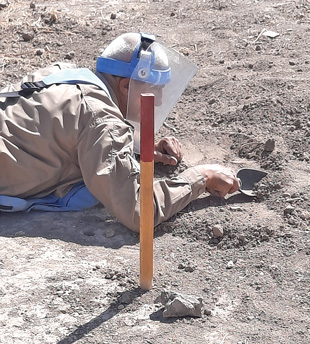
A deminer investigates a suspicious signal.
For HMA, there has been growing international debate on how funding across humanitarian activities should be allocated to facilitate the “reshaping [of] partnerships from the international to the local level … to ensure more effective, sustainable and equitable efforts.”5 What this actually means is less than clear. For some, localization is simply the inclusion of national staff within country program offices; for others, it is partnering (or sub-contracting) specific activities to local and national organizations. More cynical interpretations see the result as just the creation of chimeras—locally branded NGO clones of their INGO masters—as meeting the requirements for localization.
For Iraq, this DCA project provided a largely operational level response to the strategic and policy interests of its donors in the localization of mine action. In doing so the project avoided engaging with discussions over the need for conceptual clarity in the localization agenda. It also avoided setting down a clear and coherent strategy for the localization journey, instead focusing on an “effects-based approach.”6 This project can, in many ways, be considered a straightforward but pragmatic approach by UNMAS for clearance implementation in Iraq in the face of significant budgetary pressures—the resulting so-called “partnership” model capitalizes on the large numbers of trained mine action staff in Iraq who are often the by-products of commercial mine action interventions funded by a range of international donors in the country in previous years.7 The partnership model offers a cost-effective approach to delivering clearance capacity via INGO’s facilitating NNGO partnership agreements. While this may fall short of true “localization,” it is a welcome first step toward the localization of mine action in Iraq. It is perhaps more importantly also one that offers significant opportunities for analysis, reflection, and learning.
Reflections on Years One and Two
The DCA/IHSCO partnership set out to play a part in addressing the widespread explosive contamination in Iraq, set against a lack of national capacity to respond to it. Through the provision of cost-effective national capacity, the path to recovery and development could be set. The first two years of the partnership focused on the establishment, training, and deployment of search and clearance teams. Work was also undertaken with regards to gaining national accreditation for IHSCO to conduct search and clearance activities, as well as the establishment of the internal policies and processes necessary for their management. These were based across eight thematic areas of IHSCO’s capacity specified in the grant application process: management, programmatic, operational, support, quality management, leadership, risk management, and resource mobilization. The success of this project to date has been considerable: in terms of clearance activities delivered as an independent actor, IHSCO has completed six task orders from the National Mine Action Authority (NMAA), cleared approximately 150,000 m2 of land, and recovered 203 explosive hazards (EH), of which 189 were victim operated improvised explosive devices (VOIEDs) containing secondary switches (designed to target an explosive ordnance disposal ((EOD)) operator).
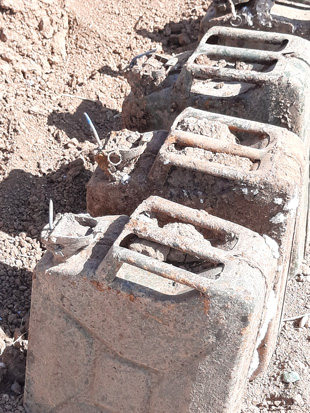
IED main charges recovered from a DCA/IHSCO work site.
The delivery of International Mine Action Standards (IMAS) technical qualifications and subsequent embedding of staff in mid- and senior-level management positions within IHSCO has seen significant development of operational command and control on clearance tasks. Broader management functions, such as personnel and professional development, continue to be developed with additional recruiting seeking to fulfill specialized HR functions. IHSCO has also gained experience in programmatic functions such as writing reports, though these have not yet been delivered directly to donors. In addition, further development of resource mobilization and proposal writing is also required. Supporting functions such as equipment and logistics management have developed to the point where IHSCO can plan and support their own operational requirements and a specific quality management officer monitors compliance and other quality issues on operational sites to a standard meeting IMAS and national mine action standards (NMAS) requirements. Additionally, IHSCO organizational leadership is clearly present and strong. The broadening of management opportunities to involve female staff is also ongoing. Risk management capacities are operationally focused but DCA has worked to embed a variety of health, safety, and other risk management initiatives and processes within IHSCO.
Of course, there have been important lessons learned along the way. Of note were issues relating to the partnering agreement between DCA and IHSCO—partnering is one of two types of agreements that DCA currently works with, the other being cooperation agreements. It was obvious that partnering in this way required careful and detailed analysis of issues normally taken for granted in other bilateral arrangements—not least those related to ownership of risk as well as financial responsibility. DCA and IHSCO have utilized accountability frameworks to address some of these challenges. It has also been clear that there is a very real need for transitional posts—that is staff that began working for DCA and moved across to IHSCO during the project. This has at times resulted in issues relating to staff integration and lines of communication. DCA and IHSCO have pragmatically resolved these issues through recognizing the specific challenges faced, recruiting an HR specialist specifically to manage this process. Learning and development needs are clearly unique to organizations and individuals and DCA has recognized the need for internal processes from early on to embed a culture of learning within IHSCO. Open and honest communication between partners is key. Budgets have remained a difficult area through the project, but genuine resolution requires serious reflection on the localization models implemented by and on behalf of donors. Finally, DCA has strived to see capacity development activities as strategic and holistic, not just operational. While the partnership model does necessarily facilitate this approach, DCA has continued to lobby for a broader context to underpin this type of localization project, a key element of DCA localization strategy.
Identifying Key Tenets of Localization
Progress in the DCA/IHSCO project by the national partner allowed the identification of what might be considered the “four pillars” of localization. Analysis of the project has shown that—from the perspective of IHSCO—these relate in general terms to “needs:”
- OWNERSHIP
- EMPOWERMENT
- COLLABORATION
- SUSTAINABILITY
The need for ownership is a central factor in the actual partnership. On the surface, it is easy to understand the need for local ownership. Matching this need with the constraints of donor agreements to which the INGO is bound is far more complex, cutting to the very heart of one of the key challenges in a localization project: how to consolidate ownership within a partnership. Donor contribution and other funding agreements aside, the ownership and management of project risk and liability (both legal and to donors) also complicates project ownership. It is clear that “local ownership” of operational level implementation activities differs significantly from “strategic ownership” of project management and delivery. Without consolidation of these perspectives on ownership there is potential for frustration on the part of the local partner with a perception of them simply being a local provider rather than local partner, excluded from any real opportunity to influence strategic issues as well as take ownership via decision making.
Empowerment in this project relates to the transfer of the skills, knowledge, and attributes from DCA to IHSCO necessary for the independent delivery of mine action activities. The transition of technical leadership is a notable achievement here that facilitated a shift to the autonomous delivery of clearance activities by IHSCO. This project has shown relative success in the transfer of operational level capacity, including in organizational management. Again, it is at the strategic level where real issues lie. Financial independence is the most obvious issue, specifically the lack of the provision of overheads direct to IHSCO (operating costs) due to current donor procurement rules. But empowerment also signposts other critical issues—the structural relationship between UNMAS and DCA (the only two signatories to the grant agreement) defines a bi-lateral relationship that provides little automatic right of IHSCO to influence this power balance, nor to interface directly with project donors. It is hard to see how this methodology can reconcile with a true localization agenda. The same structural challenges directly affect collaboration. At an operational level, daily interfacing between IHSCO and DCA is extremely effective in facilitating project delivery, yet at the strategic level there is once again an effective exclusion of IHSCO from donor interactions. These types of projects must, in the future, allow the INGO to facilitate international networks that give true visibility to the local partner. Only through this change can the necessary shift in the established norms for funding mine action be driven to ensure localization stands a real chance of success.
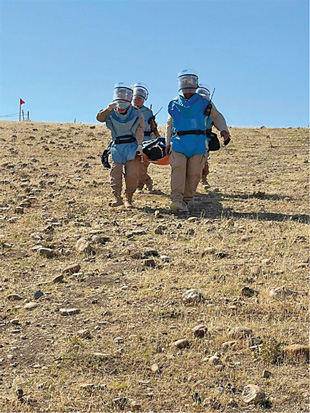
IHSCO staff rehearse casualty evacuation.
Sustainability cuts to the very raison d’etre for this project. The realities of the project delivery environment have at times placed existential pressures on both DCA and IHSCO. The current system of providing operational implementation in response to unpredictable available funding levels year on year makes it difficult for long-term commitment to localization projects to be consistently demonstrated, also increasing costs at all levels (especially administration costs). Indeed, during this project, follow-on year funding has sometimes been received so late that demobilization activities have commenced. The use of “cost” or “no cost” monthly extensions as a pragmatic work around does little to generate confidence in higher-level and longer-term commitment to localization. From the INGO perspective this also brings huge risks with regards to “underwriting” the continuation of funding in the absence of a funding commitment. For the NNGO, the effects are also profound—most visibly through the loss of trained staff who, in the possession of termination notices, move to other employment before continuation funding arrives.
Sustainability of the operating environment is another area where attention is urgently required. In Iraq there are several issues within the NMAA which appear to affect localization. In the first instance, the reluctance of the NMAA to secure any national funding for local mine action actors is clearly problematic. While DCA can perhaps not directly resolve this, its donors could certainly play a valuable role in addressing other factors affecting localization. Most notable is the current NMAA system for the prioritization of mine action activities and subsequent land release. These appear to require considerable attention, support, and influence—and are key in shaping the enabling environment prior to the launch of any future localization projects.
The very ethos of this partnership project is centered around an innovative approach to localization in mine action in Iraq. While at an operational level there has been clear success in the transfer of operational level capacities, without a more formalized and structured supporting and enabling strategic environment, the localization agenda faces considerable challenges. In localization projects there are specific strategic considerations that must be addressed during project design—one size does not and cannot fit all contexts, needs, and environments.
Big Picture and Big Issues
This DCA/IHSCO partnership project has attained significant achievements in delivering localized mine action capacity. The UNMAS model used by DCA in project design and delivery is an important part of the operational-level contribution to localization; however, it is not a complete solution in its own right—in particular not a strategic solution—to the full range of challenges that must be addressed before a coherent policy for localization in mine action can be developed. The following points represent what DCA believes to be some of the key areas requiring debate, discussion, and definition by the mine action community to continue to drive the localization agenda forward:
Conceptual Understanding. The lack of a conceptual basis for the localization project used here significantly limits the capacity of this methodology to be used as a generic model. Detailed research is required to bring more clarity and understanding to what localization means before efforts can be made to identify the specific requirements of localization project design. Localization is not capacity development, though capacity development can be an element of localization. Regardless, it is clear that detailed research is required to better understand this important relationship, in particular the alignment from the strategic to the operational level.8 More case studies and evidence must be used in concrete efforts to actually transfer power in localization initiatives. Additionally, key questions must be identified and addressed: how do we ensure more direct funding to local actors, how do we define and deliver core support, what characterizes truly equitable partnerships, and so on.
Project Design. The grant application for this project specifically required an INGO lead in a partnership with an NNGO, described as a means to ensure the INGO had “the freedom to use their own expertise and experience to deliver the project as they best see fit.” In reality, this still constrained the INGO within donor operating rules which (it could be argued) profess a rather binary vision of partnership, “based on a division between ‘Northern’ and ‘Southern’ NGOs.”9 Follow-on work for this project would logically see donors design and pilot a consortium model, characterized by all stakeholders having an equal say in project design and delivery. At the project design stage, cost/benefit simply cannot be the justification for localization, nor should the INGO be seen as the guarantor of success. The level of background analysis required to design a localization intervention must not be underestimated, nor must the process be seen as a uniform pathway across different contexts.
The Practice of Partnership. A localization project which gives financial responsibility to the INGO and not the NNGO will struggle to be an equal partnership.10 Furthermore, this perpetuates control—perceived or real—of the NNGO by the INGO. A transfer of power must be a key element of localization. While the timing and pace of this transfer of power will obviously depend on context, sufficient resources and pathways must be developed to facilitate this shift. One significant gap in this project relates to the lack of provision of overheads to the local partners. Overheads are critical for survival and sustainability and without them the NNGO partner simply cannot exist long term. While the need for overheads is starting to be recognized, how this can be facilitated—especially within common donor procurement processes—remains unclear.11 As this partnership was conceived at the project (operational) level rather than a strategic (organizational) one, it is an unfortunate consequence that this has embedded a structural disadvantage on the NNGO, specifically with regards to ownership of the project and the visibility this brings. Partnership management requires specific investment and a clear reference for ‘good practice’ is urgently required.
Driving and Measuring Progress. Localization projects require a clear and well-defined end point. This end point must articulate what needs to be achieved and what is good enough to be seen as a successful result. While milestones monitoring and evaluation mechanism in the project governance framework. As a result, there was no way of proving progress beyond the achievement of specified milestones. For a project where the specific activities delivered were the responsibility of the INGO to achieve, the use of these as a measurement of progress—as well as the driver of payments—is once again indicative of a project methodology that does little to empower the NNGO, nor share the risks present in the delivery of a project such as this. It seems that the role of the INGO as an intermediary in this project partnership more closely resembles that of a direct implementer when seen from a contractual perspective. This is not conducive to a true localization agenda.12
Moving Localization Forward
In the current global environment, the localization of HMA capacities could represent a valuable means of effectively working toward a world free from the threat of mines, explosive remnants of war (ERW), cluster munitions, improvised explosive devices (IEDs), and other related hazards. It is, however, also clear that there are a number of significant challenges to the localization agenda, each posing specific questions that require detailed research, analysis, and evaluation:
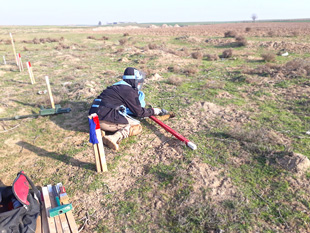
Training and mentoring is central to the DCA/IHSCO partnership. In these two pictures IHSCO staff members develop their search skills.
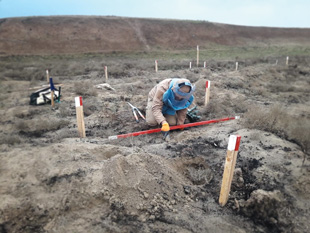
Training and mentoring is central to the DCA/IHSCO partnership. In these two pictures IHSCO staff members develop their search skills.
Structural Factors. These issues are directly related to the design of the international aid system—specifically the regulatory and governance frameworks inside INGOs, supra-national organizations such as the United Nations, and national donors who allocate funds. These “rules” impact on procurement processes, project design, and implementation, as well as monitoring and reporting. It is difficult to see how a localization agenda can be effective in the long term when the very innovation and independence it seeks to facilitate is revoked by the mechanisms of organizational control. Equal partnership and collective action should be central to localization project design, implementation, and delivery. Localization cannot simply be a temporary solution to a much larger problem.
Contextual Factors. Context matters in localization and it should be fully integrated into the project design phase. For example, how well structured and effective is the NNMA in the target country and are they supportive of and capable of supporting a localization agenda? In Iraq, the processes for prioritization of clearance activities and subsequent land release are not fully clear—this in itself has the potential to undermine partnerships between INGOs, NNGOs, and local actors and society. A certain level of maturity in the strategic management of mine action within a country would seem to be a critical component of any localization project.
Economic and Risk Factors. It has been argued that localization “is undermined by the widespread aversion of donors and external partners to engage in the perceived risks associated with applying the principles in practice since they are accountable to other actors along the aid chain … [it] requires donors and external partners to let go of control and allow flexibility, adaptability and innovative approaches over longer time frames.”13 Furthermore, projects for localization should be selected based upon need and not just donor requirements. The project DCA is currently delivering risk management in is also of concern—as the signatory to the donor grant agreement, DCA is entirely responsible for project delivery. It is hard to reconcile this with a project that seeks to embed and develop—and ultimately transfer—such a broad range of responsibilities.
Conceptual Factors. There is a clear need for a conceptual basis for localization activities in HMA. Perhaps best developed through a doctrinal basis, clear, well researched, and well-evidenced guidelines would be invaluable for the development and implementation of future initiatives. A mechanism for knowledge management, learning, and development across global mine action actors would be a valuable way to begin the process of formalizing the lessons learned across different contexts.
Concluding Thoughts
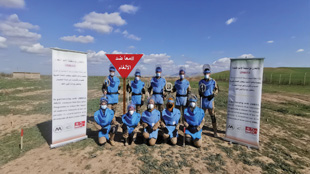
An IHSCO team photograph.
Localization of mine action activity offers huge opportunities and benefits. This project has shown that local capacity can be developed relatively cost-effectively and to a high-quality standard. That said, this project falls short of being fully successful in several areas. The development of local mine action capacity is a longer journey, not a destination. Transformation is urgently required in project design and funding modalities, as well as in designing and implementing holistic long-term strategic partnerships, if a genuine commitment to localization is to be created. Localization projects must exist within and be enabled by the strategic context, as well as the operational. A localization project that neglects careful analysis of the strategic element risks being nothing more than any other clearance project. More effort must be made to understand the context for localization projects and to ensure strategic factors are fully integrated; key here is that donors accept and understand the local agenda and context when defining their intent. Finally, a clear end point must be identified, funded, and worked toward—a year-on-year funding process which leaves the award of subsequent year finding to the last minute is neither fair on local teams nor clear in commitment to the localization agenda. Localization is vitally important in HMA but if it is to succeed then the international mine action community must show a genuine desire to open up and engage in the necessary discussions that are required to create a viable long-term solution.
Mark Wilkinson, PhD
Chief Technical Advisor
DanChurchAid
 Mark Wilkinson, PhD, is the Chief Technical Advisor for DCA. He has over twenty years of professional experience in the military and HMA. As a former British Army Ammunition Technical Officer, he worked as a High Threat Improvised Explosive Device (IED) Disposal Operator in multiple operational environments before transitioning to HMA. In his previous post as the Chief of Operations for UNMAS in Iraq, Dr. Wilkinson gained extensive experience in developing localization projects for HMA. Dr. Wilkinson has an active research agenda focused around IED clearance in HMA environments as well as localization in HMA.
Mark Wilkinson, PhD, is the Chief Technical Advisor for DCA. He has over twenty years of professional experience in the military and HMA. As a former British Army Ammunition Technical Officer, he worked as a High Threat Improvised Explosive Device (IED) Disposal Operator in multiple operational environments before transitioning to HMA. In his previous post as the Chief of Operations for UNMAS in Iraq, Dr. Wilkinson gained extensive experience in developing localization projects for HMA. Dr. Wilkinson has an active research agenda focused around IED clearance in HMA environments as well as localization in HMA.
Albert Schevey
Operations Manager
DanChurchAid
 Albert Schevey is currently serving as DCA’s Operations Manager in Iraq, overseeing the capacity building and partnership grant. Schevey comes from a diverse background with twenty-five years of combined experience in international HMA missions, both commercial and private, and defense. He was previously the explosives and safety director of a leading defense manufacturer in the United States, a former U.S. government contractor overseeing biometrics and forensics analysis for Counter-IED efforts in Afghanistan, and a former EOD technician and Anti-Terrorism instructor for the U.S. Army. Schevey holds a Bachelor of Arts in Emergency and Disaster Management and an Associate of Science in Explosive Ordnance Disposal from the American Military University.
Albert Schevey is currently serving as DCA’s Operations Manager in Iraq, overseeing the capacity building and partnership grant. Schevey comes from a diverse background with twenty-five years of combined experience in international HMA missions, both commercial and private, and defense. He was previously the explosives and safety director of a leading defense manufacturer in the United States, a former U.S. government contractor overseeing biometrics and forensics analysis for Counter-IED efforts in Afghanistan, and a former EOD technician and Anti-Terrorism instructor for the U.S. Army. Schevey holds a Bachelor of Arts in Emergency and Disaster Management and an Associate of Science in Explosive Ordnance Disposal from the American Military University.
Ahmed Al Zubaidi, PhD
Co-founder and Director
Iraqi Health and Social Care Organisation
 Ahmed Al Zubaidi, PhD, is co-founder and the director of IHSCO. He holds a Master of Business Administration, Master of Arts in International and Community Development, and a PhD in socio-
Ahmed Al Zubaidi, PhD, is co-founder and the director of IHSCO. He holds a Master of Business Administration, Master of Arts in International and Community Development, and a PhD in socio-
economic and politics with a focus on the role of Iraqi civil society in post-conflict nation building. Dr. Al Zubaidi started his NGO and HMA career with risk education in Iraq in 2003 and has expanded to cover victim assistance and search and clearance activities.
